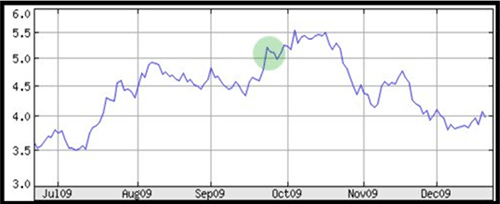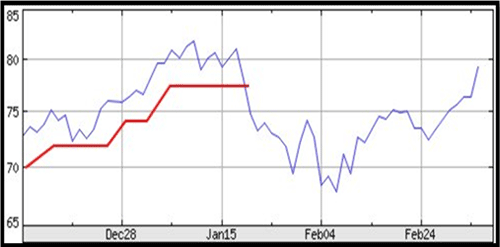Using Stop Loss Orders
The weakness of most trading systems is the lack of attention to an exit. No doubt many of you have seen charts with cute green arrows showing amazing entry points IF the trader profited out at the succeeding peak. More often than not, the trader has no other exit strategy than his gut. The trader could be in a profitable position, but suddenly feels that the stock will keep on rising. As the price reverses and the profits dwindle, they promise to sell if prices just goes back up to a former high.
One of two things may happen: the trader either marries the loss riding it for many years in the gutter, or he sells at a breakeven point. Neither scenario will make the investor money if he doesn’t have a proper exit strategy.
Aristocrat Leisure (ALL) price chart

Buying at 5 dollars could be a profitable entry depending on the exit strategy.
Two Flavors of a Stop-Loss
There are a variety of methods to exit a stock. Usually, the more complex or subjective an exit strategy is, the more opportunity the trader has to talk himself into a losing position. A couple of very clear-cut methods exist to profit out on a stock and it requires little interpretation.
- Parabolic Stop and Reversal
- Trailing Stop Loss
Another article is dedicated to the PSAR tool. In brief, it is a trailing stop-loss of sorts that tightens over time. The indicator is based on trend and momentum and provides a decent short-term exit strategy.
The Trailing Stop Loss Technique
The concept of the trailing stop-loss is very basic. If you are long in a stock, a sell order is placed a certain percentage below the current share price. If you are short in a stock, the cover order is placed a specified distance above the current value. The trailing stop loss will move in one direction but not the other.
For instance, you buy stock ABC at 10 dollars and set a trailing sell order 10 percent below the share price. Your sell order is at 9 dollars. If the stock ABC falls in value, the sell order holds at 9 dollars until triggered. If the stock moves up, so does the trailing stop-loss. If the stock were to rise to 20 dollars, the trailing stop-loss would be at 18 dollars or 10 percent below current price.
The advantages or the trailing stop-loss are apparent:
- Emotionless selling
- Locked in minimum profits (once stop-loss rises above the buy in price)
- Protection against falling prices if away from trading station
What considerations need to be made as regards where to set the trailing stop-loss? Should it be 1 or 20 percent below your buy price?
Setting the Trailing Stop Loss Wisely
Before setting the stop-loss, you need to look at your trading style. If you are a buy and hold investor it is unlikely that you will be setting a tight stop-loss of a few percent. If you are a trader that likes to hold for a few days at a time, your stop-loss will have little tolerance for wide swings. Let us consider a couple of examples.
One famous investor, William O’Neil, recommends having a stop-loss order or 7 to 8 percent below your buy in value. Should you buy and the stock immediately tank, this stop-loss will help you exit before getting into a grudge match with the stock. Some investors take this rule one step further and use it as a trailing stop-loss. This would be for a trader that can trends that last weeks to months and may rise in excess of 20 percent during this time period.
Below is a crude example of what a 5 percent trailing stop loss would look like on a chart. The blue line is the price of BHP while the red line shows the trailing stop that rises when the stock does, but remains in place to profit out if the stock falls 5 percent.
BHP with roughly 5 percent trailing stop loss order

Short term traders that trade for days to weeks, or CFD and options traders will likely find a stop-loss of 7 to 8 percent to be too wild and loose to maintain profits. They will often have a stop-loss as tight as one or two percent. Truth be told, day traders are at their terminals during open exchange hours so most will not even use stop-losses. Especially is this true from scalpers or micro-traders that might only be in a position for a few seconds. As well, stop-loss orders are usually not calculated intra-day but between days. If you purchased a stock intraday at 10 dollars and it fell to 5 dollars (as unlikely as that may seem), many trailing stop-loss programs would not pick up on it.
- Very long term investors = stop-loss of 10 – 20 percent
- Medium term investors = 7 – 8 percent stop loss
- Short term investors = 1 or 2 percent, or none at all
Setting Absolute Stops
In addition to a sliding stop-loss order, there are times when you want to place an absolute stop order. This is true when a stock is near a support or resistance level. Although you may have a 7 or 8 percent sliding stop-loss order, you might also sell if the stock breaks down below the support. Other times you want an absolute stop-loss order is if you buy after a momentum or trend breakout, as well as reversal plays. While these might be highly profitable at times, a failed breakout can quickly erode profit and capital. Placing a stop below these key points is something to consider.
Final Word on Stop-Loss Orders
Having an exit strategy is vital to the success of any trader. While a variety of methods exist to exit from fundamental to technical indicators, a trailing stop-loss is a simple and proven method to capture gains.